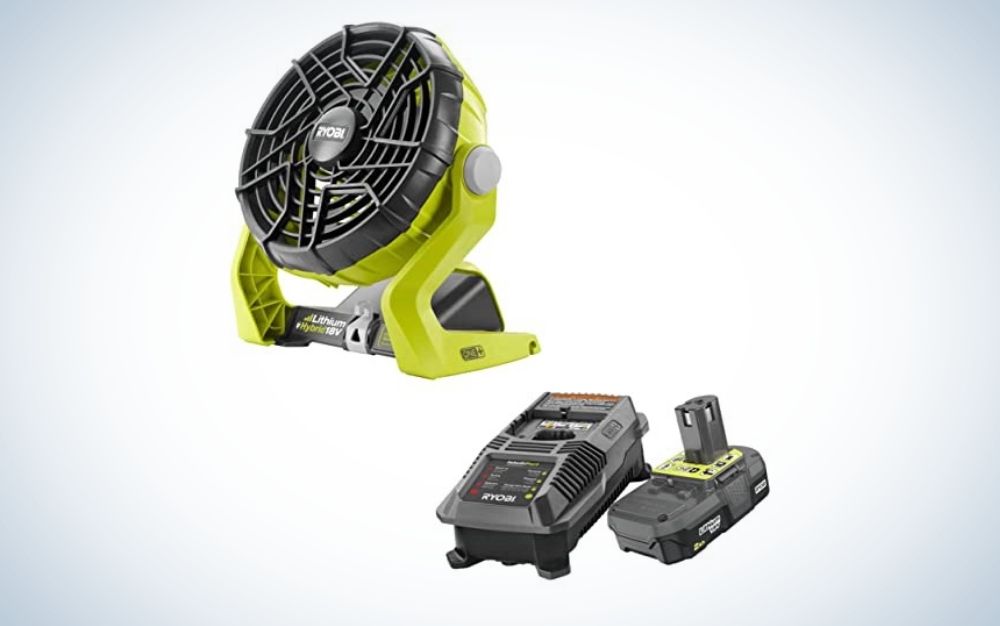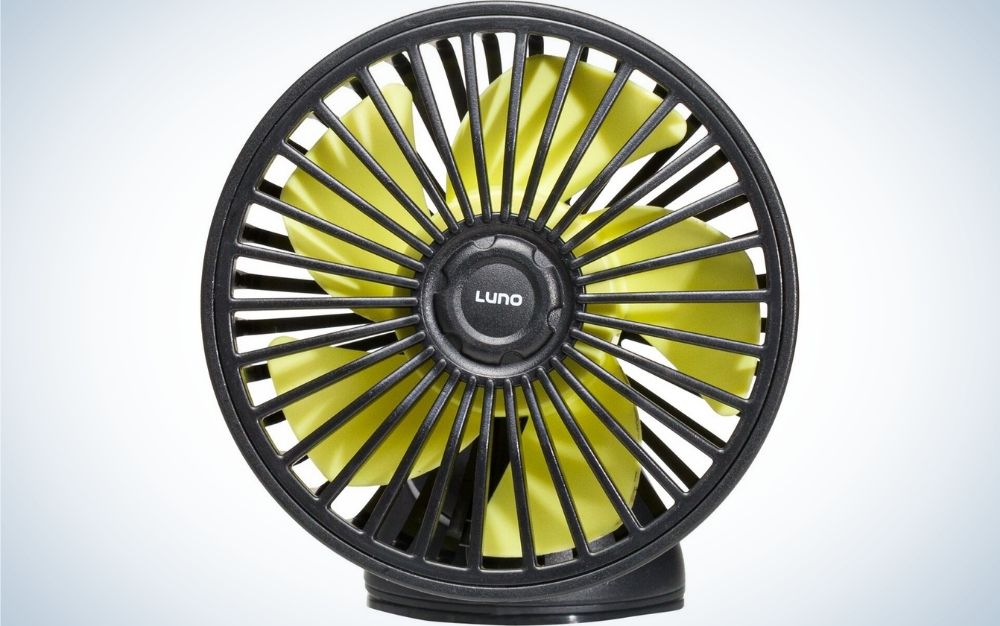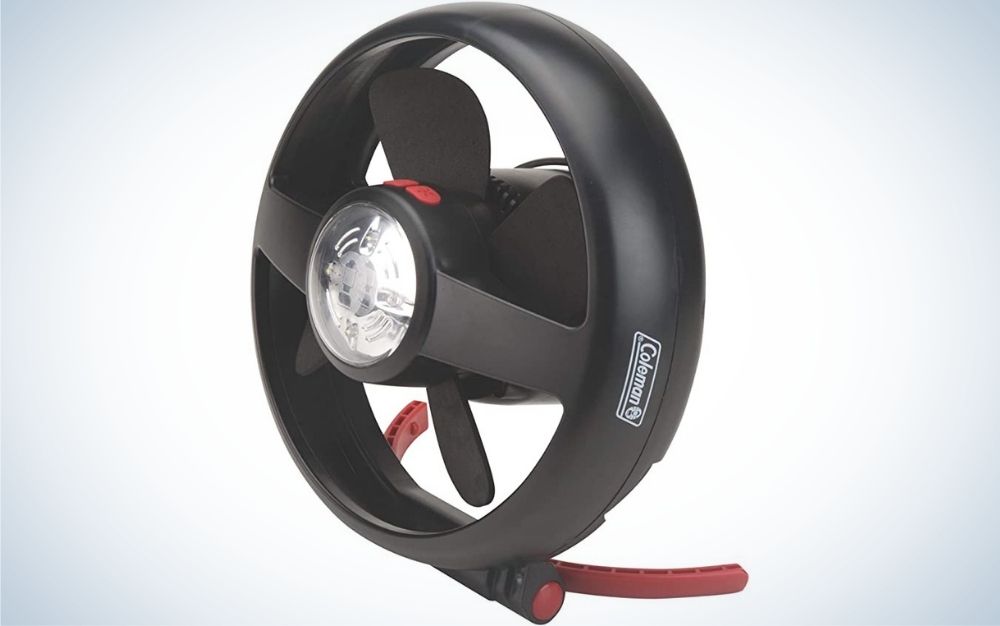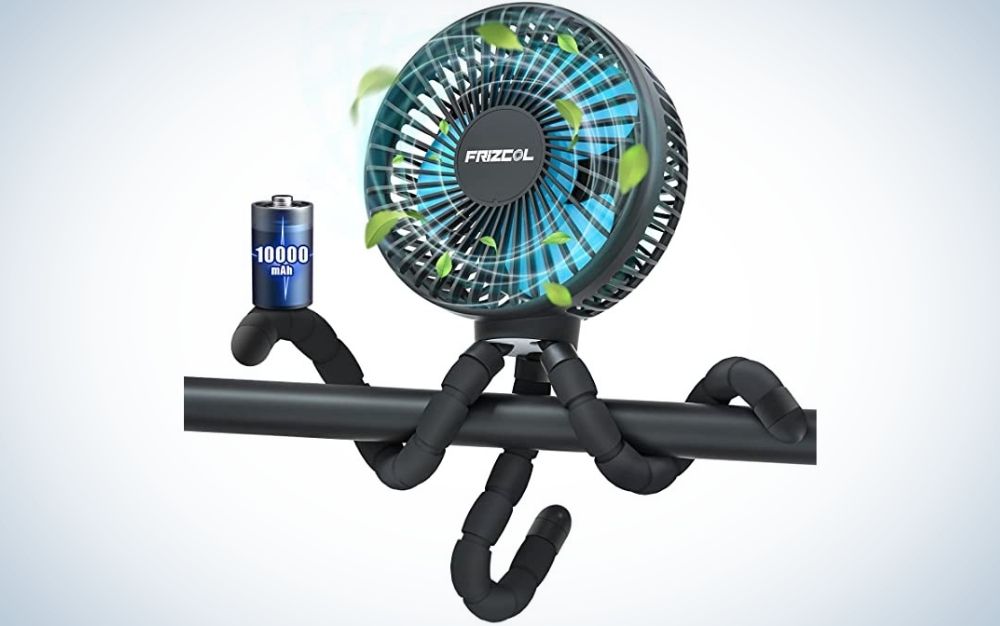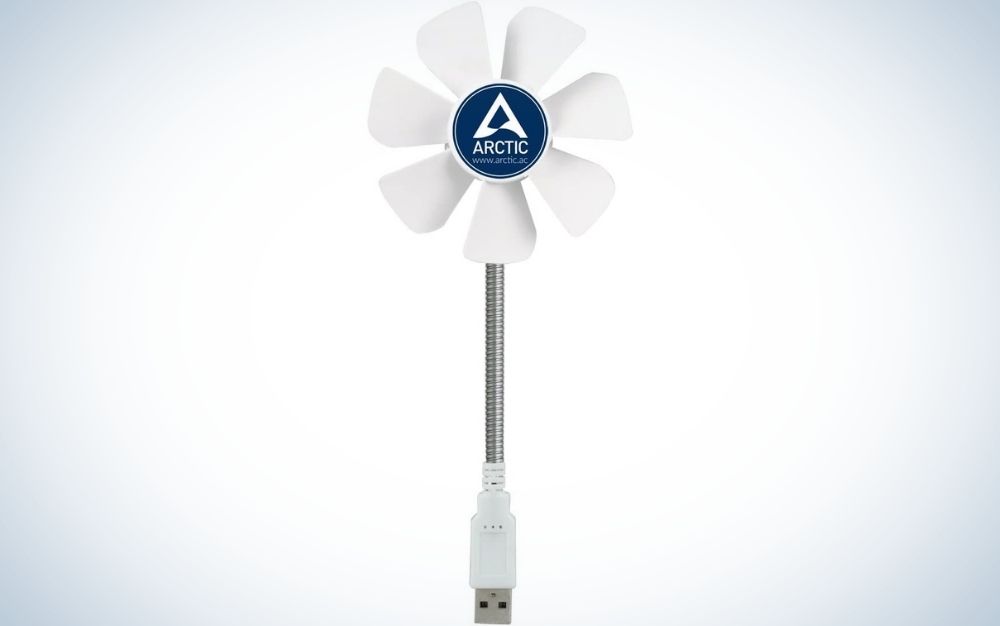[ad_1]
Updated Jun 14, 2022 2:47 PM
It’s time to add a new piece of gear to your arsenal of tools for beating the heat of August: the camping fan. But with so many options, from little handheld minis to dedicated tent ceiling fans, which one is right for your needs? To help you choose, I looked at some of the top models available and narrowed it down to five of the best camping fans available today:
Things to Consider Before Buying a Camping Fan
Purpose
One of the most important considerations when choosing a camping fan is where you intend to set it up. For some people, daytime use, when temperatures soar, is the most important factor, while others intend to turn theirs on primarily at dusk, when the mosquitoes come out to play and they want to add a little more coverage with their mosquito repellents. Others still plan to use their camping fan only at night, to keep temperatures down while they try to sleep. Consider the ways you intend to use your camping fan before making a purchase.
Size
Some of the camping fans on this list can provide enough cool air for groups of people, while others are only meant for individuals. Choose a camping fan with enough oomph to keep you cool in the conditions you expect to face.
Versatility
While most camping fans only have one intended purpose (or are only really able to function well for one intended purpose), others allow the users to set up their fan in a number of different configurations, including hanging it from the tent ceiling, setting it at the opposite side of a picnic table, sticking it to the window of a car, or even wrapping it around the pole of a camping canopy. Consider the different setups you are likely to opt for when choosing the camping fan that is right for you.
Power Source
One of the biggest differences between a camping fan and the box fan you already have at home is its power source. Rather than a typical plug that fits into a household electrical outlet, camping fans rely on one of two power sources: batteries or a camping power bank. While some camping fans use double A batteries, it is more common for camping fans to use D cell batteries, and some even come with their rechargeable batteries that can’t be swapped out. Given that fresh batteries can be hard to procure while camping, and that camping fan power usage can vary considerably, it is recommended that you bring three or four sets of spares with you to ensure your camping fan has enough juice to last your entire trip. If you plan to use a power bank for your camping fan on your next trip, consider sizing up to a larger camping power bank or bringing along a solar panel to recharge the bank on trips where you will be out for multiple days.
Safety
There are a number of ways that camping fans can inadvertently cause injury, so considering potential pain points in advance can help prevent any negative outcomes. If you are camping somewhere with variable weather, for instance, consider whether your camping fan will need to be covered at nighttime or when not in use. For anyone that is planning to hook up their camping fan overhead, look to see how secure the connection point is (those velcro tabs may not cut it), and whether they will need to be reinforced with something sturdier. Finally, if you are camping with small children (and their small fingers), it’s always worth checking to ensure that fans are both out of reach and have safety mechanisms to prevent injury.
Warranty
Compared to more established categories like the best family tents or the best sleeping bags, camping fans are a relative newcomer to the market. As such, there is a wide range of quality and durability currently on the market. I recommend choosing a camping fan from a reputable company with a good customer service department and, most importantly, a warranty.
Key Features
- Size: 11.5 inches x 11 inches
- Weight: 2.5 pounds
- Power source: external battery
- Fan speeds: two
- Warranty: three years
Why It Made the Cut
The powerful airflow of the portable RYOBI ONE+ makes it the best choice for anyone looking for serious relief in the dog days of summer.
Pros
- Powerful air flow
- Durable construction
- Dual settings work well for tent and outdoor use
Cons
- Expensive compared to other picks on this list
- Cannot be hooked up to a standard camping power bank
Product Description
For anyone looking for relief from the heavy, humid air of a broiling summer day, this is the fan for the job. Its lower setting works well to create a gentle breeze with only minimal white noise in the tent during the night, while its higher setting can cool off a group (and shoo away any pesky skeeters) during the daytime. The RYOBI ONE+ not only rotates a full 90 degrees, but it also includes a hook on the underside, so that you can secure it overhead (given its weight, I don’t recommend doing this directly over where you plan to sleep).
The biggest drawback to the RYOBI ONE+ is that it can be difficult to recharge the fan outdoors if your camping power bank doesn’t have a standard electrical outlet. For that reason, I recommend purchasing additional compatible batteries to ensure that you can stay cool for the duration of your trip.
Key Features
- Size: 4 inches x 2.25 inches x 5 inches
- Weight: 10 ounces
- Power source: plug-in requires USB-A port
- Fan speeds: three
- Warranty: one year
Why It Made the Cut
This fan is a low-profile option for staying cool in your car, whether you’re on the road or sleeping in the back at night.
Pros
- Suction cup back attaches to windows
- Swivels in all directions
Cons
- Lack of a clip or other mounting options limits usability
Product Description
The Luno Car Camping fan is designed to use in your vehicle, but it has more functionality than meets the eye. It attaches to surfaces using suction (sorry, this one doesn’t have a clip for the inside of your tent), so while its best use is for car campers sleeping inside of their vehicles, it does happily attach to a variety of other surfaces, including plastic storage bins or to the outside of your car. The small size of the Luna makes this a great choice for a single person.
Another nice detail of this car camping fan is that the on/off switch is not connected to the fan casing itself, but farther down on the power cord. That makes it easy to turn it up or down in the middle of the night without having to get up from your sleeping pad.
Key Features
- Size: 10 inches x 5.5 inches
- Weight: 3 pounds, 4 ounces
- Power source: 4 D batteries
- Fan speeds: two
- Warranty: one year
Why It Made the Cut
The Coleman CPX 6 combines both a light and a fan into one unit that attaches to the top of a standard car camping tent.
Pros
- Two-setting light provides plenty of light
- Soft blade material to prevent injury
Cons
- Batteries not included
- Lack of a guard cover means that hair could be caught inside the fan
Product Description
The most common reason to purchase a camping fan is to keep cool at night when you’re trying to sleep. To accomplish this, the Coleman CPX 6 camping fan attaches to the ceiling of your tent, where it can blow down air on everyone inside. It also includes a light with two settings, one to provide enough light for reading and family activities, and another to serve as a night light for those traveling with small children. Another reason this is one of the best camping fans is that it also has a fold-out stand, so you can set it up on the floor of your tent or near your camping chairs outside.
This fan doesn’t have plastic bars to keep out fingers because the soft foam blades won’t cause injury on their own. This means that individuals with long hair—especially voluminous long hair—should take heed that their strands don’t become entangled when they stand up in the middle of the night.
Key Features
- Size: 8 inches x 6.9 inches x 3.4 inches
- Weight: 1 pound
- Power source: 12000mAh rechargeable battery
- Fan speeds: three
- Warranty: 700 days
Why It Made the Cut
Innumerable configurations make the FRIZCOL portable fan easy to set up wherever you want to cool off.
Pros
- Quiet
- Set it up as a stationary fan, attach it to a table, or hang it from your tent’s ceiling
- Can be used to charge other devices
Cons
- Less durable than other picks on this list
Product Description
If you aren’t sure how or where you’ll want to use your camping fan, then this portable option from FRIZCOL offers plenty of options. Rather than having a solid base to stand on or a hook to hang with, it has three legs that fully bend. These allow you to wrap them around the leg of a canopy tent, attach to the side of a picnic table, perch on top of a rock, or even, thanks to its low weight, hook it to the tent’s ceiling.
This fan is noted for being on the quiet side, so it may not be the best choice for someone looking for white noise while they fall asleep. For that, I recommend the best overall and best for tents picks.
Key Features
- Size: 3.8 inches x 7.3 inches x 3.9 inches
- Weight: 9.3 ounces
- Power source: external battery pack (not included)
- Fan speeds: one
- Warranty: no
Why It Made the Cut
The ARCTIC Breeze Mobile is a low-cost, low-profile camping fan that you can use while hanging out around the picnic table or on the go.
Pros
- Inexpensive
- Simple to operate
- Quiet
Cons
- Must be attached to an external power source to use
- No option to turn up or lower speed
Product Description
Sometimes it’s not the whole family that’s overheating at the campground: it’s just you. If that sounds familiar, then consider the ARCTIC Breeze Mobile. At less than eight inches long and just over nine ounces, it’s easy to hold in one hand, and the cord connecting the fan to its power source bends, so you don’t need to crank your wrist to get the perfect upward angle.
Something different about this camping fan from the others on this list is that it requires an external battery source to operate, using a USB plug. In fact it doesn’t even have an on/off switch—just plug in and go. For most campers, this will simply mean plugging the fan into your personal-sized portable camping battery to operate, but if you don’t already have one as part of your camping arsenal, it’s something to consider before purchasing.
FAQs
Q: How much do camping fans cost?
Camping fans typically cost between $15 and $80, depending on functionality, versatility, and long-term durability.
Q: Do you need a camping fan to go camping?
For many people, camping fans are a luxury. You might purchase one to entice a loved one into the outdoors, or to make the hottest parts of the day somewhat more comfortable. In certain parts of the United States, however, where temperatures can soar into triple digits with humidity levels to match, they can take on greater importance—especially if you are also contending with mosquitoes. In these climates, camping fans can go from being a nice-to-have to a must-have.
Q: Will a fan cool a tent?
Whether or not a camping fan will cool a tent depends on a number of factors. The first is the power of the camping fan itself—a more powerful unit will do more to keep you cool than a less powerful one. Placing something cold in front of the fan can also help lower the temperature (i.e., turning it into a swamp cooler). Next is the setup of the tent. If you have the rainfly on and all the doors closed, the heat of the day will be trapped inside your tent even as the nighttime temperatures cool. You also won’t get the benefit of air circulating naturally outside. Opening and securing the tent doors, along with vents your tent has, can help lower the temperature. Finally, whether or not a fan can cool a tent does in part depend on just how hot it is outside. Even the most powerful fan will only reduce your experience of the heat by 10 degrees or so. Check the nighttime lows before heading out on your trip to determine if you’ll be comfortable.
Q: How do you run a fan while camping?
There are two main ways to run a fan while camping: batteries (including rechargeable batteries) or an external power source. The advantages of the former are that you can move your fan without needing to drag the power source along with it. The downside is that you’ll need to remember to bring extra batteries or, if using a built-in rechargeable battery, deal with a power source that tends to fade over time. External power sources are becoming increasingly common for car camping and overlanding but if you don’t already have one as part of your camping arsenal, you’ll need to acquire one first.
Methodology
To find the best camping fans available today, I looked at a number of important factors, including:
- Performance: I evaluated this based on whether there were different settings to control the speed, as well as reported experiences with how much breeze the fan produced.
- Versatility: I considered in what scenarios the camping fan could be realistically used, including in the tent, in the car, around the picnic table, while hiking, and more. I also looked at how difficult it would be to recharge away from the electrical grid.
- Durability: The durability of a product depends on its materials, although the existence of a warranty (and a customer service phone number) can provide reassurance that the product is well made.
- Price: Finally, I considered if the price for the product appropriately matched what the user could expect from it.
Final Thoughts
Camping fans might seem like a luxury for people living in more temperate parts of the country, but anyone living in the South or other hot, humid climes knows that they can be a necessity—the reason it’s possible to go camping in the first place. If you’re looking to expand your region’s camping season, or convince a first-time camper to give sleeping in the outdoors a try, then purchasing one is a no-brainer. Fortunately, there are a number of brands on the market today—in addition to the best camping fans on this list, there are units available from o2cool, Odoland, Geek Aire, opolar, and more.
[ad_2]
Source link

